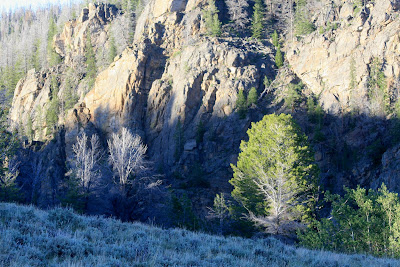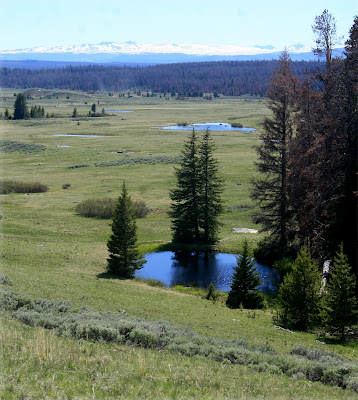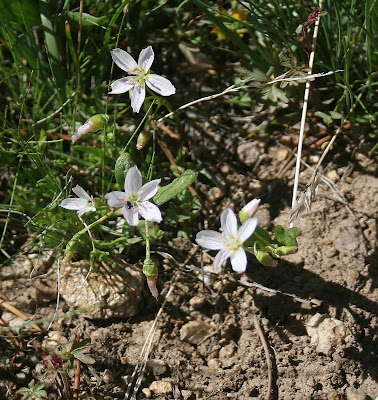
I spend countless hours exploring the outdoors where I use my camera to record this amazing world God has provided us with. This endeavor is primarily used for photo research for the art work I produce. I feel I have been truely blessed in exploring and discovering His beauty and enjoy sharing my experiences with others. I hope you will enjoy what I am doing too. Simply click on any image to enlarge it to full screen
Tuesday, July 20, 2010

[1]
July 19, 2010
I usually take mondays and tuesdays off at the gallery and from painting and spend that time in the mountains. Yesterday Vicki and I took off at 5:30 pm and headed towards the East Fork River trailhead. It is a 22 mile drive off the hiway over an increasingly rough road particularly the last 4 miles on the Shoshone National Forest. The scenery is to die for. Castle Rock rises skyward and is the leading landmark as you drive up the valley. This area is maintained for winter elk habitat and is amagnificent mix of badlands, high hills, grass and cottonwood filled valley floor. The road rises higher and higher towards the peaks of the Absarokas.
 [3]
[3]July 19, 2010
We finally make our way up and over a pass and drop down into the East Fork Basin. This is wild country with many peaks and timber covered ridges interspersed with sage and the East Fork river itself flowing along the valley floor until it enters a deep canyon to emerge further down country onto those meadows we had followed just 30 minutes earlier.
I did a pack trip into the headwaters of the East Fork River several years ago and camped at the base ot the steep sloped mountain on the left. It is an extinct volcano.
 [4]
[4]July 19, 2010
Coming to the trailhead the afternoon is fast turning to evening with the westward coursing of the sun.
With bear spray, camera and lenses and binoculars in hand we hike up the steep trail that leads into the wilderness to where we can look out over the river bottoms both upstream and downstream being able to see a lot of country and mountainsides leading up above timberline. It is quite a view of a lot of great country

[5]
July 19, 2010
From a vantage point high above the river bottoms with binoculars it is fun to scan the countryside searching for wildlife that might be found among the sage, pine covered mountainsides. There has to be many including Grizzlies but they are just not visible to us. The river bottom is covered in willows that alone could hide anything.
We are alone in the basin except for the sounds of Clarks nutcrakers that are jay like going about their business announcing to all of our presence. That and the constant hum of mosquitos. Thank goodness for mosquito spray
 [7]
[7]July 19, 2010
With a sense of reluctance we climb back out of the basin and begin our descent back off the mountain passing this huge granite face that protrudes out of the more common lava type geology of the Absarokas. It is the remnant of an ancient mountain range know as the Washakie Range that was covered long ago by the Lava flows that created the Absaroka Mountains of the yellowstone era. The canyon of the East Fork river flows far below.

[10]
July 19,2010
Looking once again down the valley floor at the early evening close of day towards the Lawyers College. This is a college structured weekly course offered by the famous trial lawyer, jerry Spence, who can be seen at times on national newscasts particularly on Good Morning America. He is not hard to miss sporting his Buckskin coat and wide brimmed hat. Here lawyers learn the fine points of working the courtroom.

[12]
July 19, 2010
Driving down the valley we come across several Pronghorn Antelope and stop to watch them awhile. Further on we run across a single very large Buck who is really intrigued with something in the tall grasses that we never could make out. He would stare ahead down into the grasses and snort and whistle then wheel and with a burst of speed tear off for 30 or 40 yards only to repeat this behavior. All the while ingnoring us completely. We watch and photograph him until the failing light becomes too late for descent pictures.
Further on down the road-definitely too late for photography we come on to a Doe Whitetail Deer who poses most magnificently for us. She is so different from the much more common Mule Deer we are accustomed to. Further still we find a Cow Moose deeply imbedded in the willows. Again escaping having her photo taken because of the darkness.
It was a great evening to be out and to experience the best of what the outdoors has to offer.
Tuesday, July 6, 2010

[1]
July 6, 2010
The past month has been pretty hectic and busy with gallery work and I find myself only getting away for brief periods of time mainly early in the mornings these past several weeks. That I have been doing. A few hours here and there for wildlife and landscape research and viewing. Most of these mornings begin with a quick stop at first light at Kathys Koffee where I arm myself with a quick picker-upperto take along. It is amazing how much the Elk calves have grown in the past several weeks. I sit at various points watching them and listening to their conversations amongst one another and to mom. Something like," Is that Gary?" "should we be concerned with his presence?" Shall we run?" Smart is the better part of valor and in no time at all they are off into the woods and safety.
Wildlife is getting harder to spot as the grass and plant life is now growing at higher elevations drawing the wildlife ever onward and upward into the high mountains as they follow both grass and melting snow.

[4]
july6, 2010
One bright early morning I spent quite a bit of time sitting and watching the sun rise and feeling the warmth slowly catch up with the nights chill. Frost was suddenly melted as the sun hit it. Watching Pine Squirrels scolding each other and harvesting cones in anticipation for next winters onslaught. Various species of birds were declaring their territories making for a most glorious early morning chorus. All the while watching the changing shadows of morning changing the face of the Wiggins Fork canyon. One bull elk now with full velvet covered antlers had come out of the willows and just as fast discovered me and was off into the timber. This is a mountain summer.

[5]
July 6, 2010
I did get away one afternoon last week heading up the Union Pass road and hiked a short distance down Kitten Creek to Wildcat Creek and back to the truck. Hiking is still a chore with this recovering? heel. Not yet sure where the point of "no return" is I don't push my luck. It is still painful and very frustrating.
Sitting for a while along Kitten Creek is a pleasant way to pass some time just watching the stream as it flows from pool to pool dropping over boulders and amongst emerging green plant life. There are still small snowdrifts here and there bridging the stream and slowly dripping their melt water into the waters adding to its flow. Another week of warm weather and they too will dissapear.
 [6]
[6]July 6, 2010
Breaking out on top onto the Union Pass I find this lone Pronghorn Antelope Doe skirting the timber on her way to who know where. Union Pass is around 9,000 feet in elevation and is a narrow sage-willow covered seemingly flat valley skirted with stands of timber protruding onto the valley floor here and there in the nearly fifty mile long by 1-3 mile wide valley. Completely snow covered in winter it is slow to give up those deep drifts of snow making summer a slow progression. It abounds in wildlife of all descriptions. Pronghorn Antelope migrate across the pass from the Red desert where they spend the winter to Jackson Hole to the west. It is the longest migration for wildlife in the lower continental United States. This is also the headwaters of the Colorado River[by way of the Green River], the Mississippi River[by way of the Missouri], and the Columbia River[by way of the Snake] A truely unique area.
 [7]
[7]July 6, 2010
I spend some time on this hillside glassing the countryside for wildlife across the vastness around me. as seen here to the soutwest are the Gros Ventre mountains. To the west are the Tetons, Their tops barely visible above the evergren hills. To the east are the Wind River Mountains and to the north are the Absarokas. I am surrounded by rugged beauty. it is a mountain summer.
 [8]
[8]July 6, 2010
The Pinnacles of the Absaroka range to the north of streams just now emerging from beneath draw filled snowbanks. A Redtail Hawk flies overhead drifting leisurly with the air currents screaming his joy of just being able to do so. Pine Siskins and Juncos flit about in the forest canopy behind me. Their songs adding to the joy of the season. It is a mountain summer.
 [9]
[9]July 6, 2010
On the mountain floor wildflowers are making their yearly appearance. Flowers that were blooming over a month ago at lower elevations are just now making their appearance at this elevation. Yellow violets and Spring Beauties such as these make for a coolorful carpet. It is a mountain summer.
 [10]
[10]July6, 2010
For several mornings I and Dustin Stephenson, our gallery potter who was in town for five days doing pottery dem;onstrations at the gallery, rose early looking for grizzlies. Another Grizzly[I am sure it is the same one we have bveen searching for all spring]has been seen periodically in the same area we have been searching. We wpend two mornings looking for this fellow to no avail vut I introduce Dustin to some incredible country he has never seen befor.
Dropping down into Wiggins Fork on the second morning from the east switchbacks raises such comments as "My wife would never come down this road." It is just wide enough for my truck and is a long way to the bottom off the edge if something happens like manuvering around those large boulders that have fallen onto the road from this springs snow melt. He is convinced though at the bottom with views such as this that it would be a great place to bring his son for fishing. On the way back up that tortuous road we stop and with glasses watch a Mule Deer Doe with a nw born fawn back down at the bottom where we have just ascended from. Yes. Summer has returned to the mountains.
Subscribe to:
Posts (Atom)






